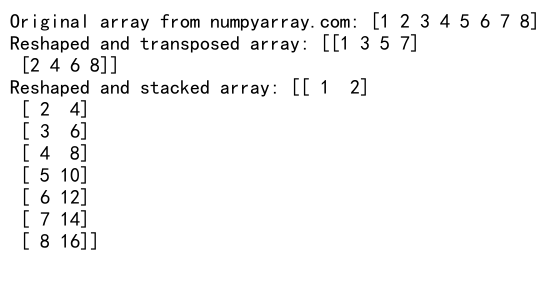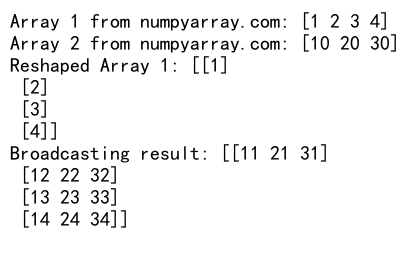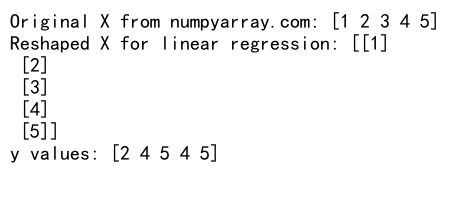Mastering NumPy Reshape with -1: A Comprehensive Guide to Flexible Array Reshaping
NumPy reshape -1 is a powerful feature in the NumPy library that allows for flexible and dynamic reshaping of arrays. This article will explore the various aspects of using numpy reshape -1, providing detailed explanations and practical examples to help you master this essential tool in data manipulation and analysis.
Understanding NumPy Reshape and the -1 Parameter
NumPy reshape -1 is a specific use case of the reshape function in NumPy, where the -1 parameter plays a crucial role in automatically determining one dimension of the reshaped array. The reshape function is used to change the shape of an array without altering its data. When using numpy reshape -1, you allow NumPy to calculate one dimension automatically based on the size of the array and the other specified dimensions.
Let’s start with a basic example to illustrate the concept of numpy reshape -1:
import numpy as np
# Create a 1D array
arr = np.array([1, 2, 3, 4, 5, 6])
# Reshape to 2D array using numpy reshape -1
reshaped_arr = arr.reshape(-1, 2)
print("Original array from numpyarray.com:", arr)
print("Reshaped array using numpy reshape -1:", reshaped_arr)
Output:

In this example, we create a 1D array with 6 elements and use numpy reshape -1 to reshape it into a 2D array. The -1 parameter tells NumPy to automatically calculate the number of rows needed to accommodate 2 columns. NumPy will determine that 3 rows are required to maintain the total number of elements.
The Flexibility of NumPy Reshape -1
One of the key advantages of using numpy reshape -1 is its flexibility in handling arrays of different sizes. Let’s explore this with another example:
import numpy as np
# Create a 1D array with 12 elements
arr = np.array([1, 2, 3, 4, 5, 6, 7, 8, 9, 10, 11, 12])
# Reshape to 3D array using numpy reshape -1
reshaped_arr = arr.reshape(2, -1, 3)
print("Original array from numpyarray.com:", arr)
print("Reshaped array using numpy reshape -1:", reshaped_arr)
Output:

In this case, we reshape a 1D array with 12 elements into a 3D array. We specify 2 as the first dimension and 3 as the last dimension, allowing numpy reshape -1 to calculate the middle dimension automatically. NumPy determines that 2 is needed for the middle dimension to maintain the total number of elements.
Using NumPy Reshape -1 with Different Array Dimensions
NumPy reshape -1 can be applied to arrays of various dimensions. Let’s examine how it works with 2D and 3D arrays:
import numpy as np
# Create a 2D array
arr_2d = np.array([[1, 2, 3], [4, 5, 6], [7, 8, 9]])
# Reshape 2D array to 1D using numpy reshape -1
reshaped_1d = arr_2d.reshape(-1)
# Create a 3D array
arr_3d = np.array([[[1, 2], [3, 4]], [[5, 6], [7, 8]]])
# Reshape 3D array to 2D using numpy reshape -1
reshaped_2d = arr_3d.reshape(-1, 2)
print("Original 2D array from numpyarray.com:", arr_2d)
print("Reshaped 1D array using numpy reshape -1:", reshaped_1d)
print("\nOriginal 3D array from numpyarray.com:", arr_3d)
print("Reshaped 2D array using numpy reshape -1:", reshaped_2d)
Output:

In this example, we first reshape a 2D array into a 1D array using numpy reshape -1. Then, we reshape a 3D array into a 2D array, specifying 2 columns and letting NumPy calculate the number of rows automatically.
Combining NumPy Reshape -1 with Other Array Operations
NumPy reshape -1 can be combined with other array operations to perform more complex transformations. Let’s explore some examples:
import numpy as np
# Create a 1D array
arr = np.array([1, 2, 3, 4, 5, 6, 7, 8])
# Reshape and transpose using numpy reshape -1
reshaped_transposed = arr.reshape(-1, 2).T
# Reshape and stack using numpy reshape -1
stacked = np.hstack((arr.reshape(-1, 1), arr.reshape(-1, 1) * 2))
print("Original array from numpyarray.com:", arr)
print("Reshaped and transposed array:", reshaped_transposed)
print("Reshaped and stacked array:", stacked)
Output:

In this example, we first reshape the array using numpy reshape -1 and then apply the transpose operation. We also demonstrate how to reshape and stack arrays horizontally using numpy reshape -1.
NumPy Reshape -1 and Broadcasting
NumPy reshape -1 can be particularly useful when working with broadcasting operations. Broadcasting allows NumPy to perform operations on arrays with different shapes. Let’s see an example:
import numpy as np
# Create two arrays
arr1 = np.array([1, 2, 3, 4])
arr2 = np.array([10, 20, 30])
# Reshape arr1 using numpy reshape -1 for broadcasting
reshaped_arr1 = arr1.reshape(-1, 1)
# Perform broadcasting
result = reshaped_arr1 + arr2
print("Array 1 from numpyarray.com:", arr1)
print("Array 2 from numpyarray.com:", arr2)
print("Reshaped Array 1:", reshaped_arr1)
print("Broadcasting result:", result)
Output:

In this example, we reshape arr1 using numpy reshape -1 to create a column vector. This allows us to perform broadcasting with arr2, which is a row vector.
NumPy Reshape -1 in Data Preprocessing
NumPy reshape -1 is often used in data preprocessing tasks, especially when working with machine learning algorithms. Here’s an example of how it can be used to prepare data for a simple linear regression:
import numpy as np
# Create sample data
X = np.array([1, 2, 3, 4, 5])
y = np.array([2, 4, 5, 4, 5])
# Reshape X using numpy reshape -1 for linear regression
X_reshaped = X.reshape(-1, 1)
print("Original X from numpyarray.com:", X)
print("Reshaped X for linear regression:", X_reshaped)
print("y values:", y)
Output:

In this example, we reshape the input features X using numpy reshape -1 to create a 2D array suitable for many machine learning algorithms, including linear regression.
Advanced Uses of NumPy Reshape -1
NumPy reshape -1 can be used in more advanced scenarios, such as reshaping multidimensional arrays or working with structured arrays. Let’s explore some examples:
import numpy as np
# Create a 3D array
arr_3d = np.array([[[1, 2], [3, 4]], [[5, 6], [7, 8]], [[9, 10], [11, 12]]])
# Reshape 3D array to 2D using numpy reshape -1
reshaped_2d = arr_3d.reshape(-1, 2)
# Create a structured array
dt = np.dtype([('name', 'U10'), ('age', 'i4'), ('weight', 'f4')])
structured_arr = np.array([('Alice', 25, 55.0), ('Bob', 30, 70.5), ('Charlie', 35, 65.2)], dtype=dt)
# Reshape structured array using numpy reshape -1
reshaped_structured = structured_arr.reshape(-1, 1)
print("Original 3D array from numpyarray.com:", arr_3d)
print("Reshaped 2D array:", reshaped_2d)
print("\nOriginal structured array from numpyarray.com:", structured_arr)
print("Reshaped structured array:", reshaped_structured)
Output:

In this example, we demonstrate how to use numpy reshape -1 with a 3D array and a structured array. The reshape operation works seamlessly with these more complex array types.
NumPy Reshape -1 and Memory Efficiency
One important aspect of numpy reshape -1 is its memory efficiency. When you use numpy reshape -1, it doesn’t create a copy of the array unless necessary. Instead, it returns a view of the original array with a different shape. This can be particularly useful when working with large datasets. Let’s examine this behavior:
import numpy as np
# Create a large array
large_arr = np.arange(1000000)
# Reshape using numpy reshape -1
reshaped_arr = large_arr.reshape(-1, 1000)
print("Original array from numpyarray.com shape:", large_arr.shape)
print("Reshaped array shape:", reshaped_arr.shape)
print("Memory shared:", np.may_share_memory(large_arr, reshaped_arr))
Output:

In this example, we create a large array and reshape it using numpy reshape -1. We then check if the original and reshaped arrays share memory, which they typically do unless a copy was necessary.
Common Pitfalls and How to Avoid Them
While numpy reshape -1 is a powerful tool, there are some common pitfalls to be aware of. Let’s explore some of these and how to avoid them:
import numpy as np
# Pitfall 1: Incompatible dimensions
arr = np.array([1, 2, 3, 4, 5, 6])
try:
reshaped = arr.reshape(4, -1)
except ValueError as e:
print("Error:", e)
# Pitfall 2: Using -1 multiple times
try:
reshaped = arr.reshape(-1, -1)
except ValueError as e:
print("Error:", e)
# Correct usage
correct_reshape = arr.reshape(2, -1)
print("Correct reshape from numpyarray.com:", correct_reshape)
Output:

In this example, we demonstrate two common pitfalls: trying to reshape with incompatible dimensions and using -1 multiple times. We also show the correct usage of numpy reshape -1.
NumPy Reshape -1 in Data Visualization
NumPy reshape -1 can be particularly useful in data visualization tasks, especially when preparing data for plotting. Let’s see an example:
import numpy as np
# Create sample data
x = np.linspace(0, 10, 100)
y = np.sin(x)
# Reshape data for 3D plotting using numpy reshape -1
X, Y = np.meshgrid(x, y)
Z = np.sin(X) * np.cos(Y)
reshaped_Z = Z.reshape(-1, 1)
print("Original Z shape from numpyarray.com:", Z.shape)
print("Reshaped Z shape:", reshaped_Z.shape)
Output:

In this example, we create 2D data for a 3D plot and then use numpy reshape -1 to reshape it into a column vector, which can be useful for certain plotting libraries or further analysis.
Performance Considerations with NumPy Reshape -1
While numpy reshape -1 is generally efficient, it’s important to consider performance when working with very large arrays or performing frequent reshape operations. Let’s explore some performance tips:
import numpy as np
# Create a large array
large_arr = np.random.rand(1000000)
# Efficient reshaping
efficient_reshape = large_arr.reshape(-1, 1000)
# Less efficient approach (avoid if possible)
less_efficient = np.array([large_arr]).T
print("Efficient reshape from numpyarray.com shape:", efficient_reshape.shape)
print("Less efficient approach shape:", less_efficient.shape)
Output:

In this example, we demonstrate an efficient use of numpy reshape -1 compared to a less efficient approach. The efficient method avoids creating unnecessary copies of the data.
NumPy Reshape -1 in Machine Learning Pipelines
NumPy reshape -1 is often used in machine learning pipelines, particularly when preparing data for model input. Let’s look at an example of how it might be used in a simple preprocessing step:
import numpy as np
# Create sample feature data
features = np.array([[1, 2, 3], [4, 5, 6], [7, 8, 9], [10, 11, 12]])
# Create sample target data
targets = np.array([0, 1, 0, 1])
# Reshape features using numpy reshape -1
reshaped_features = features.reshape(-1, 3)
# Reshape targets using numpy reshape -1
reshaped_targets = targets.reshape(-1, 1)
print("Original features from numpyarray.com:", features)
print("Reshaped features:", reshaped_features)
print("Original targets:", targets)
print("Reshaped targets:", reshaped_targets)
Output:

In this example, we reshape both feature and target data using numpy reshape -1 to prepare them for a machine learning model.
Combining NumPy Reshape -1 with Other NumPy Functions
NumPy reshape -1 can be combined with other NumPy functions to perform more complex data manipulations. Let’s explore some examples:
import numpy as np
# Create a sample array
arr = np.array([1, 2, 3, 4, 5, 6, 7, 8, 9, 10, 11, 12])
# Combine reshape with split
split_arr = np.split(arr.reshape(-1, 3), 2)
# Combine reshape with concatenate
concat_arr = np.concatenate((arr.reshape(-1, 2), arr.reshape(-1, 2)), axis=1)
print("Original array from numpyarray.com:", arr)
print("Split array:", split_arr)
print("Concatenated array:", concat_arr)
Output:

In this example, we demonstrate how numpy reshape -1 can be used in combination with np.split and np.concatenate to perform more advanced array manipulations.
NumPy reshape -1 Conclusion
NumPy reshape -1 is a versatile and powerful tool in the NumPy library that allows for flexible array reshaping. Throughout this article, we’ve explored various aspects of numpy reshape -1, including its basic usage, applications in data preprocessing and machine learning, advanced use cases, and potential pitfalls. By mastering numpy reshape -1, you can significantly enhance your data manipulation capabilities and streamline your NumPy workflows.
Remember that while numpy reshape -1 is incredibly useful, it’s important to use it judiciously and be aware of its behavior, especially when working with large datasets or in performance-critical applications. With practice and understanding, numpy reshape -1 can become an indispensable tool in your NumPy arsenal, enabling you to efficiently handle a wide range of array reshaping tasks in your data analysis and scientific computing projects.